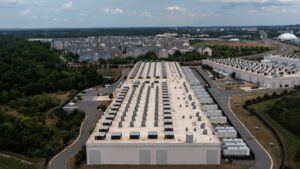Mr Lithium says he’ll ‘be dead’ before the lithium market is oversupplied

Pic: Kinga Krzeminska/Moment via Getty Images
One of the world’s foremost lithium market experts has made the bold call that the lithium market will never be oversupplied in his lifetime, saying an influx of high cost material to satisfy the demands of Chinese battery and electric vehicle makers has moved the cost curve higher than it’s ever been.
Delivering a keynote talk at the Vertical Events New World Metals Conference in Melbourne today, Global Lithium’s Joe Lowry — who has amassed a following of almost 25,000 people on the platform formerly known as Twitter with his frank and fearless commentary on the lithium industry — said prices could not return to levels that saw the industry routed between 2018 and 2020.
“I do believe oversupply will happen at some point, I believe I will probably be dead when it does happen,” Lowry told delegates at Melbourne’s Grand Hyatt hotel.
“And I don’t think I’m gonna get hit by a beer truck this afternoon so I just would say that to have lithium in oversupply with the kind of growth we’re having requires a circular economy where recycling is a meaningful part of supply.
“But the EV world isn’t at a state where you have to have enough EVs out there.
“And then they have a seven to 11 year life. And then the batteries go into energy storage for a few years.
“So it’s going to be a long, long time before the circular economy has raw material to become circular.
“The other problem with the recyclers is it’s a lot easier to get the cobalt in the nickel out of these.”
Prices near floor
Echoing the sentiments of Patriot Battery Metals (ASX:PMT) non-exec chairman and former Pilbara Minerals (ASX:PLS) boss Ken Brinsden, Lowry said an influx of low grade lepidolite that has pumped up the top end of the cost curve in China meant chemical (and by extension spodumene) prices would not head back to the low points seen in 2020.
He blamed panic buying for the highs of US$80,000/t and above for lithium hydroxide and carbonate last year at a time when the cost curve “never got above US$45,000/t”.
But despite prices falling into the high US$20,000s this year, Lowry believes they should not fall below US$25,000/t, with many of the market’s highest cost producers in China currently losing money.
“Goldman said a few weeks ago that Chinese converters will continue to operate at a loss. That’s an unsustainable thing,” Lowry said.
“Maybe they’ll operate at a loss for three or four months, OK. But you can’t operate at a loss of year in, year out. That’s not the way it works.”
“When the spodumene price goes to US$1900/t then the lepidolite is high, the high cost, but you always have a supporting underpinning price to keep it above US$25,000 in my opinion,” he said.
“And again, I don’t really care what the price is, my point is the price isn’t going to go below the cost curve on a sustained basis. And if you invest in companies that have low costs, you’ve got a very steep cost curve now.
“Low quality lepidolites are in the US$25,000-30,000 range per tonne for cost. The brine guys in Chile before royalty are under US$4000.
“It’s a pretty nice place to be if somebody’s going to keep your price up for you.”
The maths don’t work
Lowry points out that Albemarle, the world’s biggest producer, sees an 800,000t deficit by 2030.
“That’s bigger than the market was last year, so that’s how fast this market’s growing,” he said.
Yet the incentive price to bring new production online is now above US$20/kg, around current levels (though Lowry is at pains to note there is no single lithium price yet and it isn’t as of today a traditional commodity).
He said price long term price forecasts from many of the big banks continued to beggar belief.
“They never like to get pinned down to an exact number and I get it, but they make my point for me. If you don’t believe me, believe Albemarle,” he said.
“Where to from here? … Morgan Stanley says 500,000t shortage in 2030, US$1,100 spodumene and US$8000 carbonate. None of those numbers make sense if you do the math on them.
“Because it takes eight units of spodumene to make a unit of carbonate plus the conversion cost, so my warning to you is use your own brain. Don’t trust the big banks. Don’t trust me. Make your own decisions.”
Decouple? No way
Will the IRA actually help the West decouple from China?
Lowry says it’s not a magic bullet and regional supply chains which can eschew the Asian market are well over a decade away, even as Joe Biden’s administration views Canada as its 51st State and Australia as its 52nd.
ESG traceability and compliance is also easier said than done when the market is in a shortage.
“The Europeans love to talk about battery passports and traceability to ESG compliance supply, America to a lesser extent,” Lowry said.
“But when the product is short, people seem to be willing to do anything to get product and we see that with lepidolite, which is a low grade chemical. To process it there’s some nasties that come out of the processing.
“It’s almost impossible to make something from a low grade lepidolite ESG compliant but the largest battery company in the world CATL has gone all in lepidolite production.
“So if you’re going to say I have a battery passport, you’re buying from CATL, how is CATL going to say ‘well, your stuff comes from our compliance section, we just use the non compliance section in China?’.
“I don’t know what the argument is going to be but it is going to be interesting how that plays out, because it seems to me from where I watched the industry that the commitment to ESG is very nominal in many cases.”
On Chinese lithium prices, Lowry said we would continue to see “much more volatility” in China than elsewhere, saying it will have highs and lows the rest of the world won’t see.
“There are roughly 400 EV manufacturers in China, 400. A lot of them are maybe making two a year but they’re companies and that’s the nature of the Chinese beast,” he said.
“They always build too much capacity, it’s part of their DNA.”
Related Topics

UNLOCK INSIGHTS
Discover the untold stories of emerging ASX stocks.
Daily news and expert analysis, it's free to subscribe.
By proceeding, you confirm you understand that we handle personal information in accordance with our Privacy Policy.








